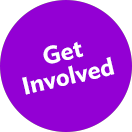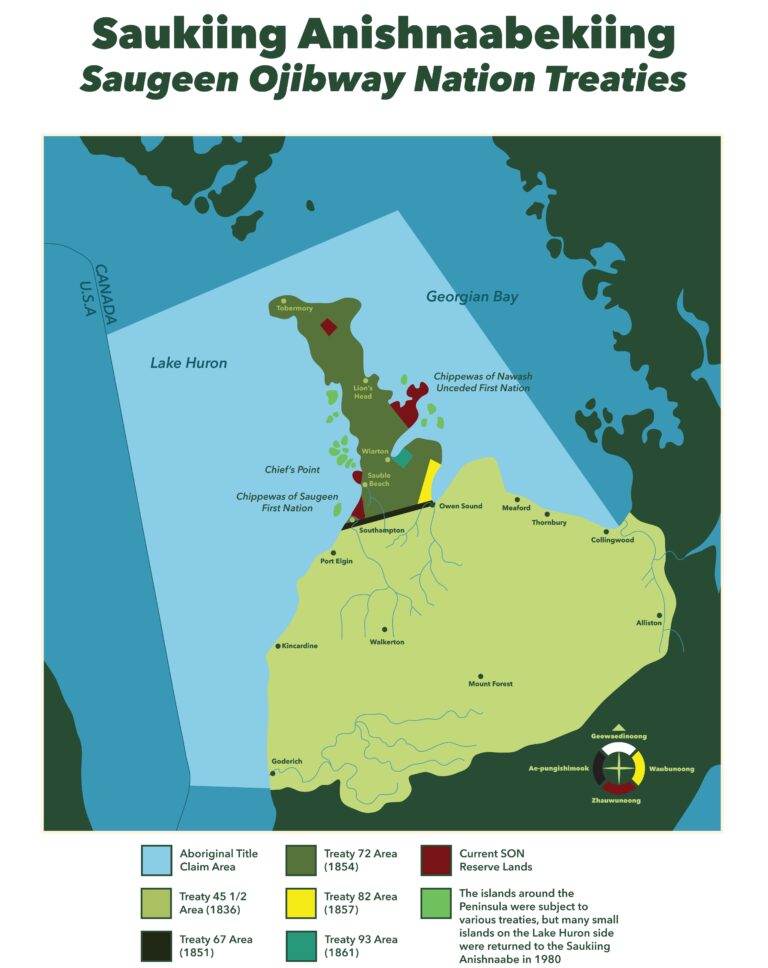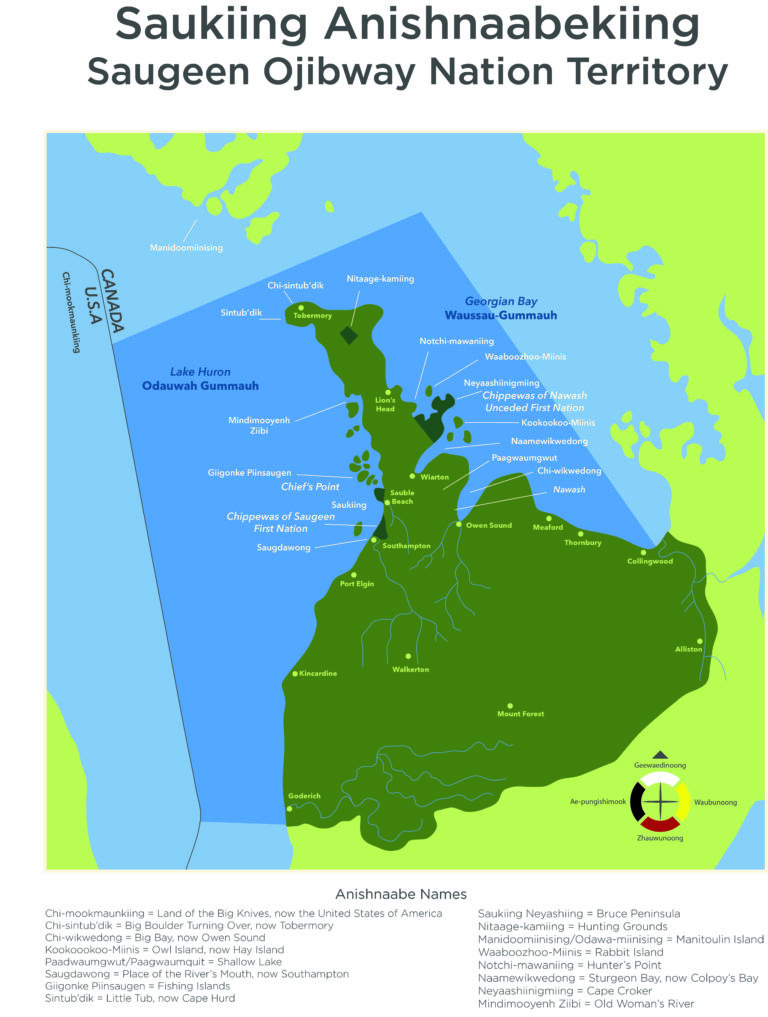Reconciliation
Home | Reconciliation
Land Acknowledgement
Bruce County is located on the traditional territory of the Saugeen Ojibway Nation, which includes the Chippewas of Nawash Unceded First Nation and the Chippewas of Saugeen First Nation.
Bruce County Council and staff want to acknowledge the Traditional Territory of the Anishinaabek Nation: The People of the Three Fires known as Ojibway, Odawa, and Pottawatomie Nations, on whose ancestral, traditional and treaty lands and territories we, our residents and municipal governments are located. And further give thanks to the Chippewas of Saugeen, and the Chippewas of Nawash, now known as the Saugeen Ojibway Nation, as the traditional keepers of this land.
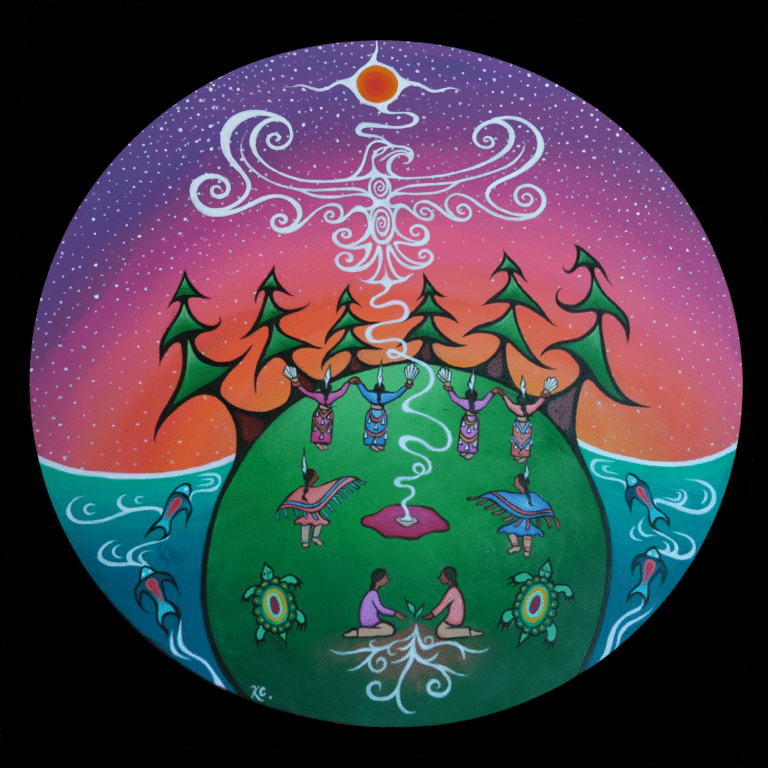
Aki Ogichidaa
The commissioning of original artwork by local Indigenous artist Kennedy Cameron-Nashkewa of Saugeen First Nation honours the connection that Anishinaabe people share with the land. Aki Ogichidaa is an Ojibway phrase which translates to Protectors of the Land. Aki (ah-kay) means “earth, land, ground,” while Ogichidaa (oh-gich-ih-daa) means “a warrior or veteran.”
The original piece is on permanent display in council chambers at the Administration Centre in Walkerton and features in digital format in the Land Acknowledgement Protocol, a reminder of the County’s connection and commitment to reconciliation.
About the Artwork: Aki Ogichidaa – Protectors of the Land
This painting symbolizes the connection that Anishinaabe people share with the land, and with that and Anishinaabe way of acknowledging the land, the ancestors, and the responsibility we carry forward. Centered in ceremony and connections, the imagery reflects our relationship to all living beings. Those who
walk, swim, fly, and those who dance. The figures in regalia honour the dances that bring our communities together in celebration and prayer.
The thunderbird is a helper to the spirit, who looks after Anishinaabe, they carry our thoughts and intentions to the spirit realm, reminding us that the land is alive, sacred, andlistening. In the spring they return to renew life. As Anishinaabe, acknowledging the land is in how we live, how we relate, and how we care for creation. This painting is my way of giving thanks to the land that holds us, to the ancestors who guide us, and to the generations yet to come. May this piece invite reflection, respect, and a renewed sense of responsibility. For we are all part of the circle.
About the Artist: Kennedy Cameron-Nashkewa
Aanii/Hello, my name is Kennedy Cameron Nashkewa, I am a seventeen-year-old Anishinaabe Kwe born and raised in my home Saugeen First Nation, I am the youngest daughter of four from my beautiful and resilient mother. Art is an outlet for me, helping me express the pride and deep-rooted respect I have for my culture and my people.
I am very grateful for the opportunities I’ve been given to be a positive role model for other Anishinaabe youth across turtle island, my place in the world as an artist is tightly tied to my community and family, and with every painting I create I hope to also create a way to honour them.
Reconciliation is a Journey
Just as we are on our Reconciliation Journey, you can continue with yours. Follow the links below to learn how to start your reconciliation journey, the 94 Calls to Action, important Indigenous causes, and First Nations in Bruce County.
What is the Truth and Reconciliation Commission?
Saugeen Ojibway Nation
Saugeen First Nation #29 (SFN) is made up of a distinct Anishnaabek Nation. They are comprised of the Three Fires Confederacy. They are located on the Lake Huron side of the Peninsula just North of Southampton.
The Chippewas of Nawash Unceded First Nation
Neyaashiinigmiing Indian Reserve No. 27 (formerly Cape Croker Indian Reserve) is located North of Wiarton on the Georgian Bay side of the Peninsula. Cape Croker Indian Reserve like every settlement on the planet is consistently changing and was officially named “Neyaashiinigmiing” on January 21, 1992. It means “point of land surrounded on three sides by water.”
Saugeen Ojibway Nation Environment Office
Saugeen Ojibway Nation Environment Office provides coordination and support to the Joint Council on matters that impact or may potentially impact rights, interests and jurisdiction in Saukiing Anishnaabekiing. The Environment Office receives direction from Joint Council to work on matters in the Territory that include (but are not limited to): land use, resource extraction, energy production and waste management. The goal of the Environment Office is to support Joint Council in making informed, sound and strategic political decisions that reinforce and strengthen their stewardship in the Territory.
They are the custodians of the culture, for it is by the language and the stories that a people’s culture and history are known. Some of the stories of the elders of Neyaashiinigmiing are told in two books about them published by the Band.
Bruce County Resources
Bruce County Saugeen Anishnaabek Reconciliation Pathway and Action Plan
Indigenous Reconciliation Framework
On July 4, 2024, at a Special joint meeting of County Council with Council members from both First Nations, County Council endorsed the Bruce County’s Indigenous Reconciliation Framework, and Bruce County’s Saugeen Anishnaabek Reconciliation Pathway and Action Plan.
Bruce County is committed to meaningful reconciliation through the Indigenous Reconciliation Framework and the Saugeen Anishnaabek Reconciliation Pathway and Action Plan. Guided by a distinctions-based approach, we recognize the unique rights, identities, and priorities of First Nations, Métis, and Inuit peoples, ensuring our actions are respectful and responsive. The Framework sets out Bruce County’s commitments and principles for reconciliation with all Indigenous peoples, while the Pathway and Action Plan focuses on our government-to-government relationship with the Saugeen Anishnaabek (Chippewas of Nawash Unceded First Nation and Chippewas of Saugeen First Nation). This phased approach begins with strengthening these foundational relationships before expanding to engage with Métis, urban Indigenous communities, and Indigenous serving organizations. Through ongoing collaboration, Bruce County is committed to taking meaningful steps toward reconciliation.
How can I start my Reconciliation journey?
How to be an effective ally to Indigenous communities – Guidelines for Allyship | APTN
Being an ally to indigenous people | Queen’s University
Historical Timeline: Indigenous Milestones impacting Saugeen Ojibway Nation
Reading List: See a full list of reading resources to help you learn about the Saugeen Ojibway Nation.
Understanding Rights
United Nations Declaration on the Rights of Indigenous Peoples
Jordan’s Principle is a human rights principle established by the Canadian Human Rights Tribunal (CHRT) to make sure that First Nations children do not face gaps, delays, or denials in accessing government services because of their identity as First Nations children.
Initiatives for Change
Missing and murdered Indigenous women, girls and 2SLGBTQI+ people
In response to calls for action from Indigenous families, communities and organizations, as well as non-governmental and international organizations, the Government of Canada launched an entirely independent National Inquiry into Missing and Murdered Indigenous Women and Girls in September 2016. Indigenous women and girls are more likely to go missing or to be murdered than non-Indigenous women and girls. We are working with provinces, territories, Indigenous organizations and communities nationwide to end this crisis and ensure their safety.
The Moose Hide Campaign began as a BC-born Indigenous-led grassroots movement to engage men and boys in ending violence towards women and children. It has since grown into a nationwide movement of Indigenous and non-Indigenous Canadians from local communities, First Nations, governments, schools, colleges/universities, police forces and many other organizations – all committed to taking action to end this violence
The Gord Downie and Chanie Wenjack Fund
Inspired by Chanie’s story and Gord’s call to build a better Canada, the Gord Downie & Chanie Wenjack Fund (DWF) aims to build cultural understanding and create a path toward reconciliation between Indigenous and non-Indigenous peoples. DWF’s goal is to improve the lives of Indigenous people by building awareness, education, and connections between all peoples in Canada.
The Legacy of Hope Foundation (LHF) is a national, Indigenous-led, charitable organization that has been working to promote healing and Reconciliation in Canada for over 25 years. Their purpose is to foster empathy and understanding and inspire positive action by educating Canadians about the history and ongoing impacts of the Residential School and Day School Systems, and subsequent Sixties Scoop, and other negative legislation. LHF also works with Survivors to create projects such as Cultural Reclamation and Revitalization Workshops that support the well-being and empowerment of Indigenous (First Nations, Inuit, and Métis) Survivors, their families, and communities. The LHF offers 30 exhibitions, K-12 curricula, 2 podcast series, and other educational resources to promote equity and allyship. LHF also does Equity, Diversity, and Inclusion Training for Governments, businesses, organizations, etc.
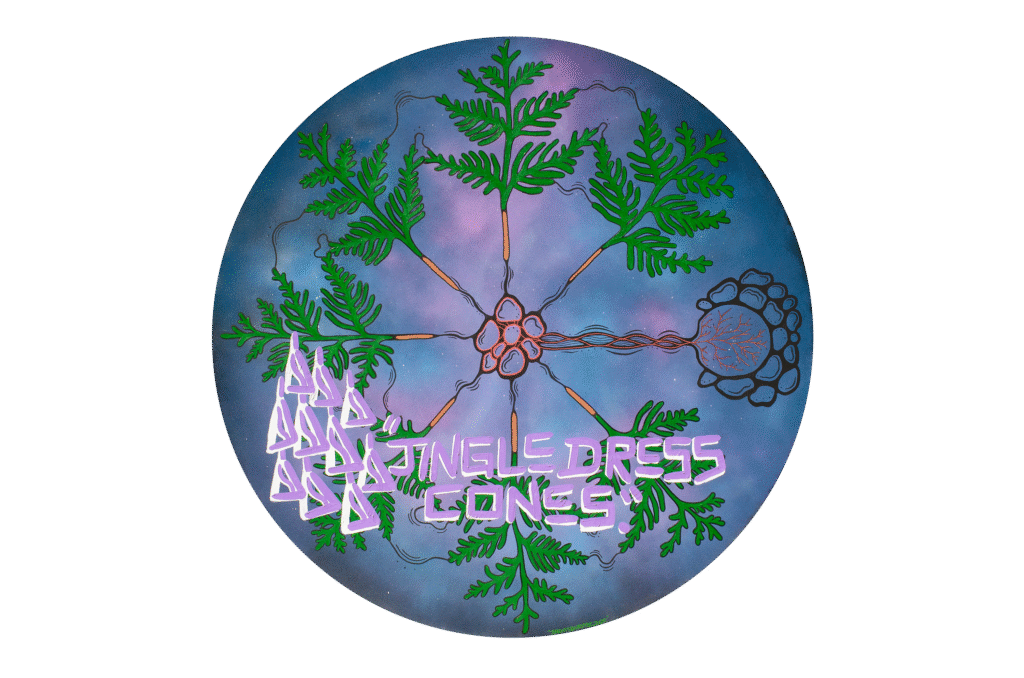
Medicine by Brent Henry
Using themes of Truth as a foundation for this portrait of Truth & Reconciliation, Brent explores the main message of healing. Traditional medicine is healing, the knowledge and ways of the Anishinaabe people are healing, as are the gifts from Mother Earth. Through embracing these gifts, we can begin to truly heal from the continued traumas of colonization, ethno-stress, and Canada’s Residential School System. Some of the gifts of Earth expressed in this artwork are cedar, the medicine for sweat lodge; sweetgrass, to bless the Grandfathers; and the Universe, the portal through which we and our ancestors see each other.
Each jingle cone is a prayer, and these songs link Truth & Reconciliation into a more specific story of truth and healing through medicine and joyous cultural practices. Each marker of symbolism is a marker of the strength and resilience of the people and our ways. This painting explores and expresses that viewfinder between our ancestors and ourselves that sweat lodge can create, just one example of joyfully living, learning, practicing, and healing through the culture.
About the Artist
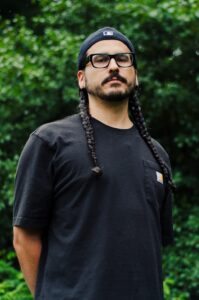
Brent Henry
Brent’s creativity lies with his heritage and roots. His father, born in Saugeen First Nation, and his mother, from Newfoundland provided a strong platform to raise from. Working himself in and amongst Saugeen during his youth, Brent derives his creativity from culture, continuous learning, and constant exposure to community. Brent has gone on to work closely with local Chef Zach Keeshig and his award-winning restaurant Naagan, curated works with the Tom Thomson Art Gallery, and has most recently had multiple works included in the Red Visions exhibit of Indigenous Art at Cast Loma Toronto. He continues to always create while learning about his Anishinaabe culture and way of life, as this is the strongest informer to all creation, art especially.
